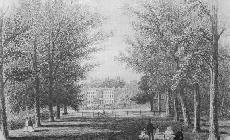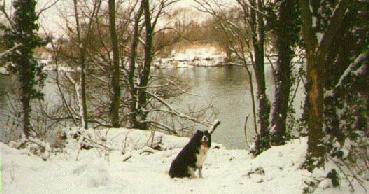The growth of Nottingham
into a city has inevitably threatened the Groves character over the last
fifty years. Even in the mid 1800s the Grove must have seemed a remarkable
piece of countryside to lie so close to the town. The heavy industrialization
of Clifton colliery at nearby Wilford in 1871 paved the way for expansion
into the surrounding areas. A large green buffer of playing fields
limit the proximity of commercial buildings on the west bank of the Trent
to a moderate intrusion. The huge gray slab of Clifton Bridge carrying
the A52 over the Trent in the North beside the little Fairham Brook bridge
is an eyesore. Somehow the young green trees and shrubs that wall the path
into the Grove manage to absorb and hide its presence. |
 |
|
View Of The Trent From
The Top Of The Grove Cliff
(Photographed May 1997)
|
|
The ground is a little bare around
the bridge after a recent summer of small fires that were thankfully controlled
before to much damage was done. The Clifton
village has grown dramatically in size since the forties and can no longer
be really called a village as is now a sprawling housing estate populated
by around 30,000 people. The houses, inevitably, and new Trent University
buildings have been built right up to the corridor of trees along the top
of the cliff thus robbing the Grove of its detachment from urban life.
To make matters worse the ancient Elms have all gone, ravaged by Dutch
Elm disease in the 1970s. New trees have been planted but are many
years away from the splendor of the previous generation. Today the
Grove is still a peaceful, rich area of woodland worth exploring.
It does not have the same crowd pulling reputation as in previous years
but is still popular with the locals. Its an ideal place for exercising
dogs (I walk my dog there most weekends), cycling, fishing, summer strolls
and winter tobogganing. Canoes and rowing boats regularly cruise the Trent
in the mornings.
 |
|
The River At The Foot Of The Grove
(Photographed January 1st, 1997)
|
|
The Legend Of Clifton
Grove
Legend has it that a young squire
in the service of Sir Gervase Clifton and a maiden of Clifton fell in love
just before the Battle Of Bosworth in 1485. The maiden gave the squire
half a gold piece as a token of her love and pledged to wait for his return
when they would marry. She retained the other half of the gold coin
as her own momento of love. The squire followed William Clifton to
fight in France. Eventually he returned to marry his beloved only
to find the maiden had broken her promise and married a wealthy local man.
He is then said to have killed himself by plunging into the Trent in dispair. |
The guilt ridden maiden was soon after dragged into the river by a demon at
the great 'chasm' in the the grove below Clifton Hall. The Nottingham
poet, Henry Kirke White wrote the poem called 'Clifton Grove' that
has a number of verses devoted to the legend. Click
here to view extracts from Kirke White's Clifton
Grove along with more grove pictures.
. |





